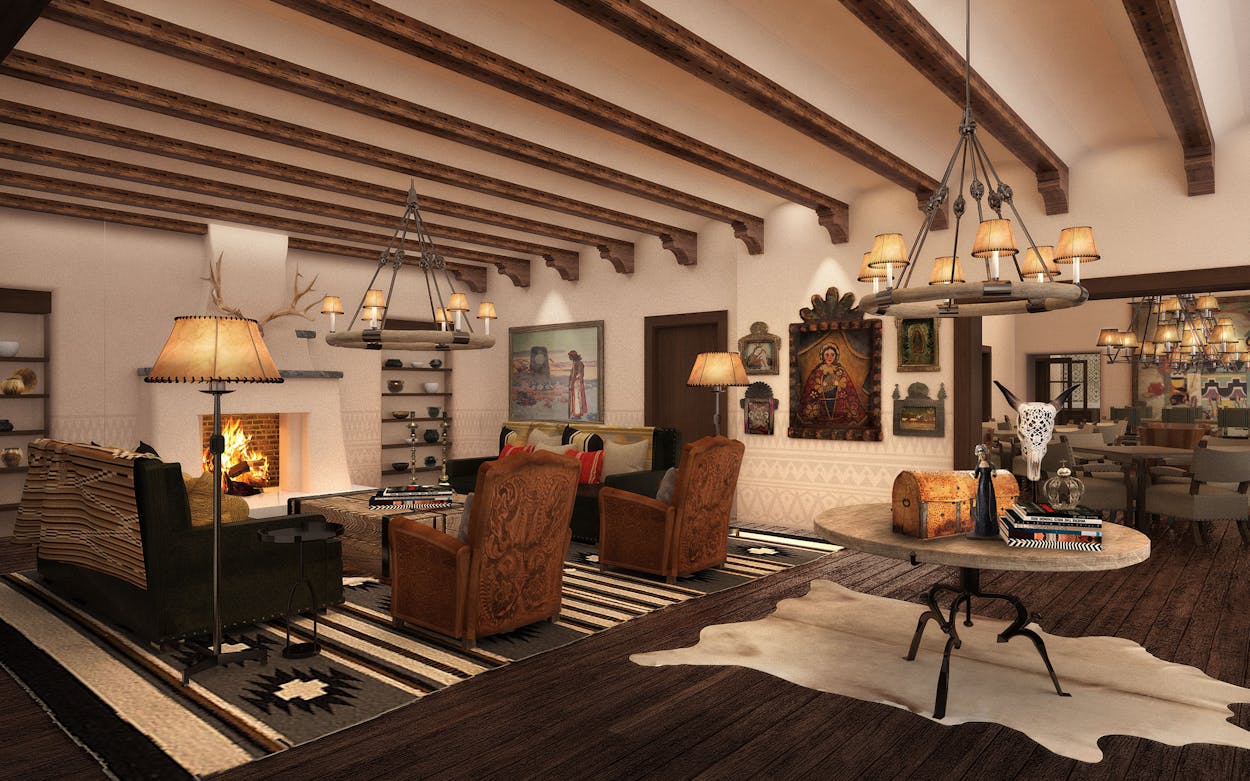From chakra-realignment treatments and smoky mezcal cocktails to sunsets that cast a blush across the Sangre de Cristo Mountains, the new Bishop’s Lodge, Auberge Resorts Collection tips its custom beaver-felt cowboy hat to New Mexico’s sundry marvels. Guests at this historic Santa Fe property, which reopened this spring under the luxury Auberge umbrella, can fly-fish, fine-dine, stargaze through telescopes, throw pottery with the on-site ceramist, and ride horses into the forest.
Among the pine and juniper and trout streams on the resort’s 317 secluded acres, the new elegant adobe-like structures designed by Dallas-based architect Nunzio Marc DeSantis hark back to pre-Hispanic times, when the Pueblo Indians, sophisticated horticulturists and builders along the Rio Grande, erected multistory adobe homes, some with hundreds of rooms. “The architecture here is simply a canvas to showcase the environment,” DeSantis says. Details that bow to the scenery and climate include “a whole language of trellis concepts” that he constructed throughout the property. “Santa Fe is high desert,” he explains, “and the sun isn’t always your friend. We made trellises with wood branches to protect guests from the sun when necessary, filter light, and create a dappling of shadows.”
Though adobe and other elements of pre-Hispanic culture survived Spain’s colonization of the Americas at the end of the sixteenth century, regional gastronomy changed as ranching replaced hunting. Beloved Dallas chef Dean Fearing, who ran the Mansion at Turtle Creek for two decades before opening Fearing’s Restaurant, is behind the resort’s signature restaurant, SkyFire. He finds inspiration in ancestral contributions such as maiz and chiles as well as the European influence of cattle-based cooking. At SkyFire, Fearing aims to capture “New Mexican heaven”—a fusion of smoky flavors, grilling, and chiles.
With his wood-fired grill, Fearing replicates old rancher recipes. Exhibit A: the “mopped” ribeye. “Right before you take it off the grill,” Fearing says, “you mop it with molasses, beer, and vinegar. Sweet and savory.” He goes on to explain the history: “In the 1800s, every Southwestern household had molasses for biscuits, beer for drinking, and vinegar for cooking and medicine. During town festivals, they’d roast half a steer over a pit for eighteen hours. To keep the meat from drying out, they’d mop it with that mixture. There was an actual bucket and mop.”
New Mexico was once unspoiled Native land, and later the domain of European ranchers, and today it’s also the “Land of Enchantment,” the title of a 1906 book by Lilian Whiting that stuck. The state, particularly Santa Fe, has long been a magnet for New Agers—the seekers, the spiritual set—and the Turquesa Healing Arts Studio at Bishop’s Lodge vibes with that crystal-encrusted aesthetic. Though guests can book ordinary massages, it’s much more than a spa. Most spas don’t offer a meditation jacuzzi, art therapy, or an herb garden where guests pick their own herbs for bespoke treatments. Most spas don’t have a solid turquoise foot-soaking pool, either. “In Turquesa, we celebrate turquoise as our foundational stone,” says DeSantis. “Turquoise has great meaning in this part of the world—you’ll see it in jewelry and pottery. The pigment is used in paint. Some believe it has healing power. We’ve worked turquoise into the outdoor gardens, the treatment rooms, the spa pool. It’s a big part of Santa Fe that we’ve embraced.”
A version of this article originally appeared in the May 2021 issue of Texas Monthly with the headline “Retreat to Santa Fe.” Subscribe today.
- More About:
- Where to Stay Now







